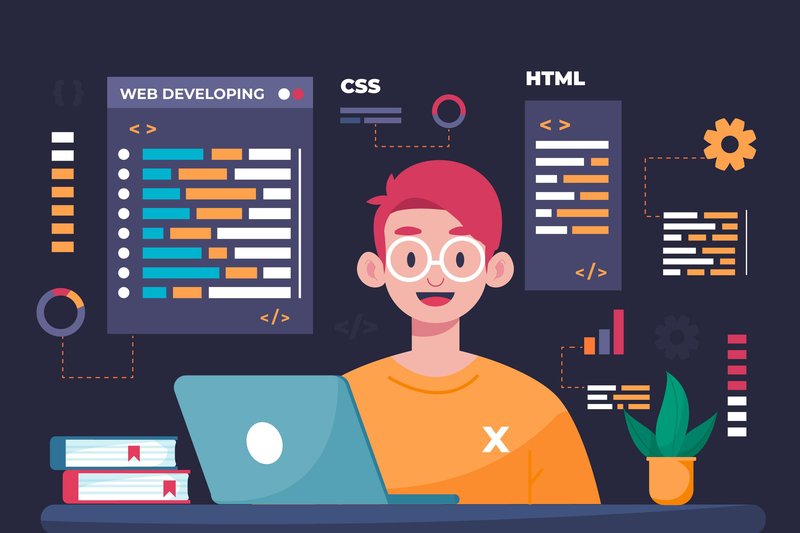2024 Web Development: Challenges, Solutions & Trends
Creating a user-friendly and high-performing web application is not an easy task. There are many challenges in website development services in 2024. Look at some of the most common website application development challenges that you'll encounter during the planning stages of your website app. It is not an easy task to create a user-friendly and high-performing web application. This article will assist you in understanding and avoiding bespoke website development services difficulties that may arise while developing an application. So, what exactly is website application development?
What exactly is Web Application Development?

Web application development is the process of creating application programs that are stored on remote servers and delivered to the user’s device via the Internet. A web application is not downloaded and is instead accessed via a network.
A web application can be accessed by an end-user using a web browser such as Google Chrome, Safari, or Mozilla Firefox. JavaScript, Cascading Style Sheets (CSS), and HTML5 can be used to create the vast majority of web apps.
Top Web Development Challenges and its Solutions.

Setting up Goals and Objectives:
Planning according to your vision is fundamental for building a website. So, clearly define your goals. Otherwise, it affects everything that follows.
Solution:
Define clearly the intended/target users, kind of web application, must-have design features, technical requirements, and the exact experience you want to give to your customers.
Choosing Best Tech-Stack
Technology Stack consists of a set of programming languages, frameworks, servers, software, and other development tools. They are, in essence, a collection of technologies utilized by a web development company to generate web or mobile app development. The wrong selection of tech stack will backfire on your business.
Solution:
Always choose a technological stack that is suitable for the problems you are trying to solve. You’ll have access to a large pool of skilled developers for your initial development and future demands if you use industry-standard tech stacks.
Browser Compatibility
Browser and platform compatibility are typically one of the biggest challenges for web developers. Therefore, you need to make sure the sites work on all the existing browsers on the internet and devices of different screen sizes.
This step becomes crucial due to legacy browsers that do not support modern features, security measures, and layouts. One of the most famous examples of legacy browsers being a nightmare for web development is Internet Explorer. Due to its poor performance, Microsoft announced that its services will be discontinued after June 15th, 2022.
As a result, you need to make extra efforts to enable your website to work on such browsers which are no less than a challenge. Prioritize maintaining website compatibility across different browsers, especially when you have to deal with legacy browsers like IE or others. Apart from the inherent problems of legacy browsers, you will also have to deal with some common issues like
HTML/CSS validation: Different browsers read the HTML/CSS code differently, which can pose a genuine challenge for website developers.
Layout difference: Different browsers support different design layouts. As a result, websites render distinctly as per the layout compatibility with the browsers and cause UX inconsistency.
Solution:
- You can overcome this challenge by validating HTML/CSS, handling doctype errors, detecting outdated browsers, etc.
- Maintain layout compatibility in all environments.
- Test on real devices.
User Experience and Simplistic Design (UX/UI)
Websites must be responsive and should have intuitive navigation not only on PCs but also on smaller screens i.e. mobiles. The proliferation of smartphones with various screen resolutions has brought new ways to access online content which comes with a host of web development challenges. Also, the number of website visitors from smartphones and tablets is increasing every day, and the trend is certain to continue.
Also, keep in mind that the user’s perception must sync with the purpose you designing the app. If your web design seems complex and confusing, the visitors will waste no time leaving your site. So, maintaining the intuitive UI/UX across all devices will become the biggest challenge.
Solution:
- Using the best UI elements or component-based UI development helps achieve intuitive UI/UX.
- Across all web pages, maintain a consistent design.
- Make sure to provide clear navigation, easy-to-read typography, and engaging visuals.
- Ensure you design simple steps for filling out any forms on the website.
- Make sure your web application is mobile-friendly.
Website Scalability
Scalability is not about performance or making excellent use of processing power and bandwidth. It’s about balancing the load amongst the servers, so when the load increases, more servers may be added to balance it. You should not put all of the load on a single server, but rather build the software to run on a cluster of servers
Solution:
- When more servers are added, service-oriented architecture (SOA) can help to improve scalability. SOA allows you to adapt quickly and easily.
- A service-oriented architecture (SOA) is a design in which application components give services to other components via a communication protocol, typically over a network.
Performance and Speed
It is well acknowledged that website speed is critical to the success of a website. When it comes to running a business online, every second matters. Web apps that are too slow are a failure. Customers will abandon your website as a result, damaging both your revenue and reputation.
Before designing a web application, it is suggested that you consider performance initially. Poorly written code, unoptimized databases, unmanaged data growth, traffic surges, poor load distribution, default setup, troublesome third-party services, and so on are some of the performance difficulties.
Solution:
- Optimize various elements such as navigational buttons, content, interface layers, etc. to maximize website performance.
- CMS Website Development allows you to take control over your entire web content without writing a single line of code.
- Compress images and implement caching.
Web Security Threat
Website security is essential, especially when 50% of web applications are susceptible to high-risk vulnerabilities. Additionally, cyberattacks have increased drastically over the past few years, with only 5% of enterprise data folders protected against threats.
Securing your website is exhausting with several vulnerabilities to counter. For example, passing on unfiltered data to an SQL server, browser, or even an LDAP server can lead to injection flaws. It allows an attacker to induce command functions that corrupt the browser leading to data loss.
Another website vulnerability comes from broken authentications. Session hijacking due to authentication issues can lead to data risks and identity theft.
Solution:
- Your website must be coded carefully to provide robust security.
- Create multi-factor authentication and robust password requirements.
- Have an SSL certificate for encrypted communication between web browsers and servers.
3rd Party Integration
Every website will have some third-party integrations such as Payment gateways, Social media integrations, Maps, and Multi-language support. And there also will be technological incompatibilities between the architecture of your website and the third-party service providers. If we don’t integrate this third-party software securely, it becomes a security risk providing a vulnerability to loopholes.
Solution:
The best solution to address API issues is to ensure that your website architecture is in sync with the changes made by third-party service providers. You can have QA teams collaborate with service providers to obtain complete information on the required changes in the architecture or the API code.
Also, you need to make sure that the changes in the API code reflect within the website architecture for uninterrupted performance. Here, maintenance of the website codes and regular upgrades can be beneficial to the performance level and reduce the cost of development.
Maintenance & Support
The true challenge arises once your website goes online. Following the debut, several difficulties such as unresponsive websites, security issues, slow loading speeds, and performance issues arise. Upgrading the core of the website or updating legacy APIs for security might be difficult. Additionally, ensuring zero downtime during website maintenance is difficult. Different dependencies among functions can cause downtime throughout this operation. This is especially noticeable in monolithic websites with closely coupled services and operations
Solution:
When it comes to maintenance challenges, monitoring becomes essential. You need to monitor the vitals of your website constantly to ensure immediate fix of any issue that arises. Furthermore, you need to have a web architecture with minimal dependencies for higher uptime during the upgrade process.
Conclusion Remark:
Web development is a large sector that includes not only the creation of websites but also the creation of web applications and other web services. Similarly, the obstacles to web development are not confined to the points described above. Every business has a distinct goal that presents distinct problems.
The development team must approach each difficulty differently. If you are seeking a firm that delivers clever solutions for Web and mobile app development difficulties, Decodemind is the best choice to supply you with the correct answer.
Do not let obstacles damage the quality of your online project when you have the correct answer in hand. Contact us right now!

 Hamid Salman
Hamid Salman